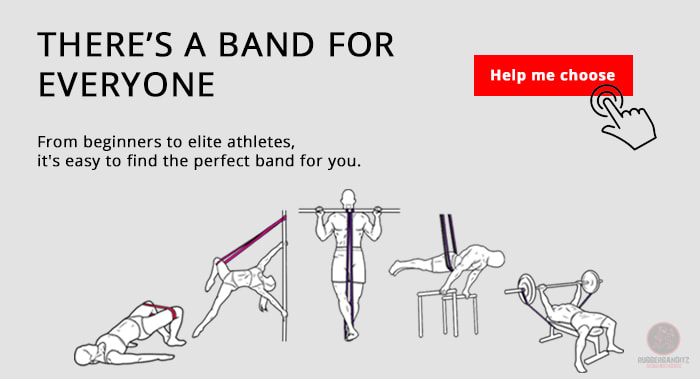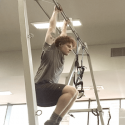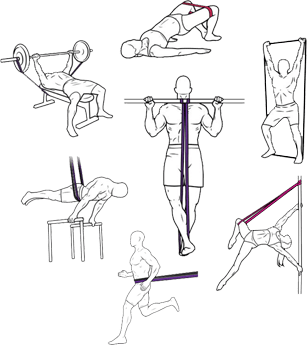Welcome back to today’s episode of Pull Up Pandemonium.
Today we ask the cruel but entirely necessary question:
“What do we do when we suspect chin ups and pull ups are getting too easy?”
I know, there are twisted/motivated individuals out there that need to make chin ups [and/or pull-ups] harder so they can keep progressing. It’s true.
First thing we should probably discuss is how to determine when you know you’ve reached that pedestal yourself. Obviously, everyone’s metrics and judgments are a little different, but for me, I think if you can do 3 sets of between 3 and 5 strict and controlled repetitions with the chest touching the bar at the top of each rep, I would begin adding weight.
You’re probably thinking, “That’s not even very many chin ups. I was expecting more like 3 sets of 10 or 15.
And that’s fair. But I’ve observed a lot of people get to 3 sets of 5 reps and then plateau unexplainably, never to see a 6th rep set in their lives.
How do you make pull-ups harder?
My solution to this is surprisingly simple and goes a little like this: add 2-3 lbs (1 kg) per week to the set you can already do. Going from a 3-rep set to a 4-rep set is an increase of 33%; massive when you put it on paper like that. Adding 1kg/2.5lb to even a 50 kg/125 lb body is only a 2% increase but provides a sustained platform for the long-term growth.
What I’ve seen with this solution is consistent progress in a sustainable way, and when people are doing +10kg/12.5lb a month or two later, they often unweight their set and knock out the 6-rep set they’d never quite managed before. Sounds almost too simple, right?
The idea I’m talking about here is a central one in fitness and health: progressive overload. If you go for a one mile run and do it in 8 minutes, in order to improve or progress, you’d have to either:
- Run longer than one mile
- Run one mile in less time
- Feel like the same run was easier than last time
The same goes here for weighted chin ups. Find a way to improve by one or two percent every day so that it is achievable for you rather than trying to make jumps of forty or fifty percent in the same period and you’ll find that your chin ups come along quickly when you end up looking back a few months.
When considering this as directly related to chin ups, that might mean that if you can do 3 strict reps without weight, you do one repetition with 3lb of added weight, and then two without weight. If you can approach things with this slow but deliberate approach, you’ll see the progress and repetition increase that you’re looking for.
If you’re in a position where you can’t quite get to a weight vest or don’t have the right weight plates to do this job, you can also use a light resistance band for pullups to create that load. I personally use this approach for the professionals I train who travel regularly as well as the bodyweight training enthusiasts who tend to prefer to workout with portable calisthenics functional bodyweight training accessories.
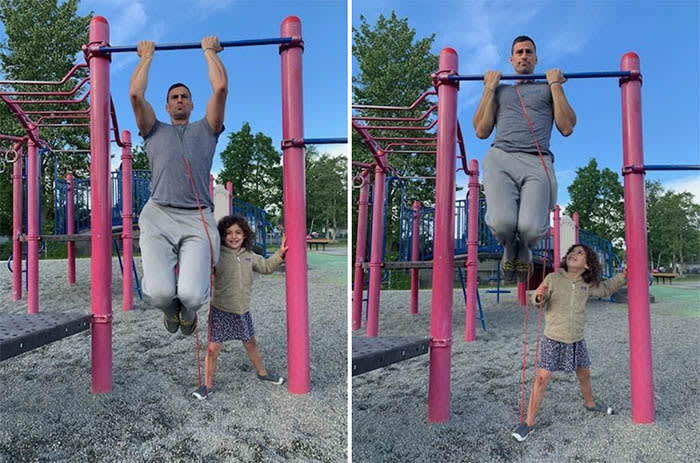
The setup is easy, simply wrap a band over your shoulder and anchor the other end down near the ground so that as you pull yourself up, the band stretches and adds an incremental amount of resistance through your range of motion. You can use a kettlebell, dumbbell, rack pin, or have someone stand on the other bottom of the band to anchor it down for resistance.
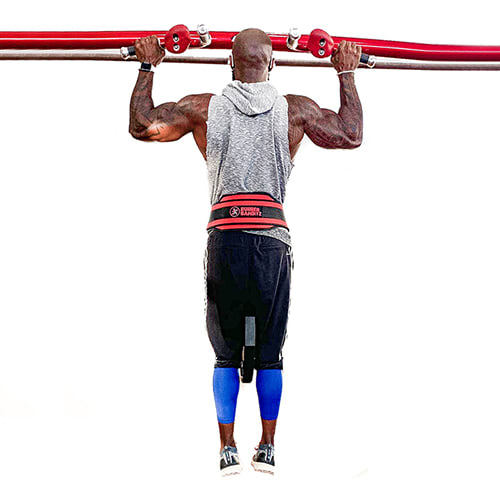
The difference between doing a traditional weighted pull up and a banded one is that weighted pull ups are similarly heavy throughout the entire range of motion, where banded pull ups (using pull-up bands) get harder as one reaches the top of the movement as the elasticity of the band creates more force. For people who are traveling or headed to the park, the other obvious difference is that pullup bands weigh less and take consume less space. Resistance bands are also easy to quickly modify the amount of resistance you are challenged by incrementally shorting the exposed length of the band to create additional drag.
Regardless if choose to use weights, belts or bands, the objective is to find a light amount of resistance once you can bang out the basic 3 sets of 3 reps with good form. Adding weight, not just reps, is the smartest way to go if you want to improve and break those early onset plateaus. When you hit sets of 10 or more (once again using an arbitrary example to make the point rather than this being the strict point where everything magically changes), the difference between 10 and 11 repetitions becomes a much smaller percentage (10% increase rather than the initial 33%) for you to potentially add repetitions and increase in that way. Simple enough, but so often overlooked.
In terms on the nitty gritty, I’ll personally add weight to my sets in one of two ways. The first is by using a weighted pullup belt (what a convenient coincidence that we also carry our custom weighted pullup belts in our store [wink wink].
This is one of the most convenient ways of weighting your chin ups and pull ups if have access to free weight plates. You can also MacGyver the weight belt by holding a dumbbell or any heavy object between your legs.
Now that we’ve discussed when you should do weighted pull ups and how to do them, let’s consider how weighted pull ups might make their way into your program and why else you should do them.
The first is an obvious enough one; chin ups are currently in your strength or bodybuilding program, but you haven’t been able to break past the plateau you’ve been experiencing. Here, we would progressively overload using weighted pull ups as I’ve described above to beat that break through that sticking point for you. Putting a couple of pounds on your belt will allow you to progress that couple of percent every workout. Putting the pounds on your belt for a sustained period will inevitably have you back doing more unweighted chin ups once you strip out the extra resistance.
The next reason you might have weighted pull ups in your program is that relative strength or bodyweight strength is a focus of yours. The chin up is obviously a flagship bodyweight exercise, and therefore, you’d be following your interests if bodyweight strength is something you are passionate about improving. If you want to increase your power to bodyweight ratio, or relative strength, chin ups are a must have. With gym machines, such a lat pull down, since you don’t actually pull yourself up it becomes easier to cheat by using your momentum to counterbalance the pull, and all you have to focus on is the total weight you pull down. However, with strict chin ups, since you are pulling yourself up, you’re forced to engage various stabilizer muscles. If you have had a sloppy couple of weeks eating, your body also gives you immediate feedback.
I do also enjoy using bodyweight exercises as a way to more regularly “feel” your body and how it moves. Going back to our comparison between the lat pull down machine and a pull up- with the lat pull down you are moving a bar through space, not your body, as you do with a chin up. We are less in-tune with the way our body moves and feels when performing functional movements such as pull-ups.
Another ancillary reason is to increase variety. You may have had pulldowns and rows in your program forever and have had little to no chin ups variations. If this is the accurate it may be a great reason to incorporate weighted/resisted pull-ups as a way to stimulate your workouts with variety and muscle confusion.
Last but not least in this list is because they directly relate to your goals. Want a stronger/heavier weighted chin up? Bouldering or climbing regularly? Looking to get a skill like a one arm chin up? Then common sense says practicing weighted chin ups and their varieties is a good idea to accomplish your goals.
In short, the best way to improve your pullups is to do more pullups.
Now obviously it’s important to relate how we do our chin ups to our goals to ensure we’re still being smart about the ways we do them. A single rep of the heaviest possible weight might not help you much if you want to be able to do 20 repetitions of weighted chin ups at +20kg/45lb. So, this means that me recommending things to you would likely vary a lot based on your individual goals.
To expand on this, generally speaking people are in one of two camps: “I want the heaviest weighted chin up possible” or “I want the most chin up repetitions possible”. If you tend to be more in the first camp, keep your repetitions per set to 5 or below and ensure you are working specifically in low rep ranges to get stronger in low rep ranges. On the flipside, doing sets of 5 or less isn’t going to be the most effective way to add repetitions to a 20-repetition set of chin ups. For that, you would be best working on your weighted pull ups with sets of 10+ repetitions and cluster setting (sets with very short rests between sets) unweighted pull ups to get that desired effect.
The other point we would have to address is the frequency and total volume of training.
Obviously the two general groups or goals I have set out here are quite different. If I were aiming to improve on repetitions of chin ups, I think I would have one training session that is heavier than the other, focusing on 3 sets of weighted chin ups at a weight that allows to do 50% or more than your max unweighted number of repetitions. (Eg: MAX unweighted pull ups are 20, you must do 3 sets of weighted pull ups that end up with more than 10 repetitions per set). After this, I would move off to a non-back related exercise to allow some time to recover before we do two cluster sets of unweighted pull ups. In these cluster sets, we should stop two reps before we are spent and feel like we are going to fail. Take a 20-30 second break and begin a new set. This will allow our body to adapt to doing more work in less time, and therefore to a tolerance for larger set volumes.
As for strength, I would keep it much less complicated. Doing two separate days, one with 3 sets of 5 at whatever weight you can manage that for and another day with 3 sets of 2 or 3 would be fine. Ensure that in both cases we aim to move quickly though the concentric portion [the pull up] and lower yourself down in a controlled manner.
Need a pull-up band? Look no further.
Need a pullup bar? Got one right here.
You got this. Give yourself a new challenge and get yourself up the bar.



